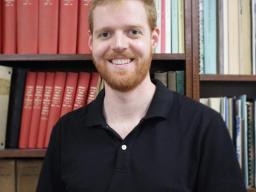Daniel May at the US Forest History Society
A photo from the 1920 'Big Burn' from the Forest History Society collection. The caption: "This is all that is left of a thrifty Lodgepole pine forest in Idaho after the 1910 fires. The author got the smoke of these fires that summer in Colorado, 800 miles away. Such burned areas must be replanted since there is no live tree for miles. "
Thursday 16 August 2018
Daniel May recently concluded a six-week research visit to Forest History Society. When asked about his visit to the FHS, he responded:
"I'm here to work on my doctoral thesis on the contemporary and historical politics of indigenous burning in Australia and the United States. Both Aboriginal Australian and Native American societies used (and some continue to use) fire for a wide range of reasons, which shaped our environment today. There are also big similarities in how non-indigenous people in both countries have understood indigenous burning, and how these understandings have influenced political debates over fuel reduction, logging, and grazing. With increasing public interest in restored 'cultural burning' and a major fire deficit, it's critical that contemporary debates be historically informed."
Daniel discovered many records useful for his research at the FHS archives, reporting:
"Firstly, I've been looking at U.S. Forest Service archival collections relating to the 1910 Big Burn, and public debate surrounding the "light burning" dispute of the early 20th century. The papers of Dr. Harold Weaver (a pioneer prescribed burning scientist) have been helpful. And I've been taking advantage of the Library's extensive collection of forestry and fire-related books and journals, which are simply unavailable in Australia."
Image Gallery
Daniel MAy at the Forest History Society archives
